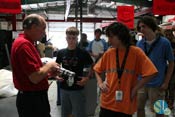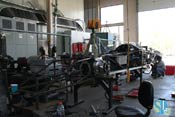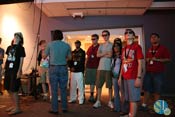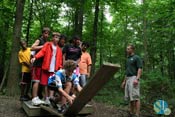Overview
For the last 18 years, Ohio's gifted* high school students and their teachers have been given the educational opportunity of a lifetime.
Computing and technology are integral parts of our every day lives. Dramatic changes in technology have inpacted our work, play, education, and commerce. Those who remain on the pulse of technological change today will be the leaders in academia, business, and government tomorrow.
To prepare these future technology leaders, the Ohio Supercomputer Center (OSC), offers a two-week residential program that provides academically outstanding* Ohio high school freshmen, sophomores, and teachers hands-on experience with some of the nation's best supercomputers.
OSC employs a faculty of experts in high performance computing (HPC), networking, engineering and the sciences to teach students computing fundamentals such as programming language, parallel processing techniques, and visualization toolkits.
Students and teachers worked together on team projects to apply what they learned in lectures. With the guidance of an SI staff member, they worked in small groups to solve real-world, research level science and engineering problems in fields such as chemistry, structural engineering, and atomic physics. On the final day of SI, students formally presented their findings to an audience comprised of family members, SI staff, and OSC guests.
Activities are not limited to the projects. Experts from computer science, engineering and the sciences spoke about their latest research and give rare insight into careers in science, engineering and computing. Outside of the walls of OSC, students participated in a team-building day, as well as science-related field trips in the Central Ohio area.
Objectives:
- Get hands-on experience on supercomputers and cutting-edge technologies
- Work collaboratively with a team to complete a research level project
- Experience working in a real-world research environment
- Actively learn programming language, parallel processing techniques, and visualization toolkits
- Follow the scientific method used by researchers all over the world
- Learn about careers in computing, networking, science and engineering
- Learn and socialize with students with common interests
* Gifted according to OAC 3301-51-15
Participants
|
Matthew Baron Peter Beaucage Sapan Bhuta Saptarshi Chaudhuri Gregory Condit Richard Georgeoff Jeff Graetz Keith Hawkins Kevin Hawkins Charlie Hughes |
Daniel Jacobs Ryan Johnson Ben Lee Maya Madhavan Matt Mayberry Sheena Patel Joey Starnes Bryce Theobald Shawn Wang Xiaojing Wu |
Projects
The students worked together in small teams on diverse and challenging research-level projects. Teams were comprised of a project leader (staff member who conceived and designed the project), students in the project group, a high school teacher and a student leader (in charge of dividing project tasks).
The team projects offered vary from year to year. This year's projects included: Network Forensics, Molecular Dynamics of the Bird Flu Virus, Kinetic and Statistical Descriptions of Matter, Game Programming and Motion Capture and the Comet Project.
Students did a vast amount of work in a short period of time to finish their projects. It was a crash course in time management. First, they learned UNIX, the operating system of the computers they used. Then they learned a programming language, such as C, C++ or Python, to write the code to solve their problem. Students were required to do their own work from code implementation to final presentations. The ability to develop algorithms and an understanding of the project's science/engineering basis were needed to facilitate code writing. Finally, the students made a video animation displaying their simulation data -- which was the ultimate goal of each project. Groups presented their findings and animations to family members, OSC staff, and guests attending the SI Closing Ceremonies.
Schedule
Click here to download a detailed schedule.








